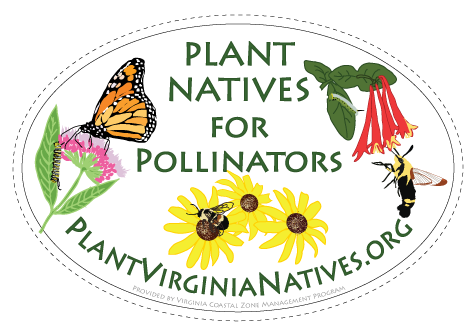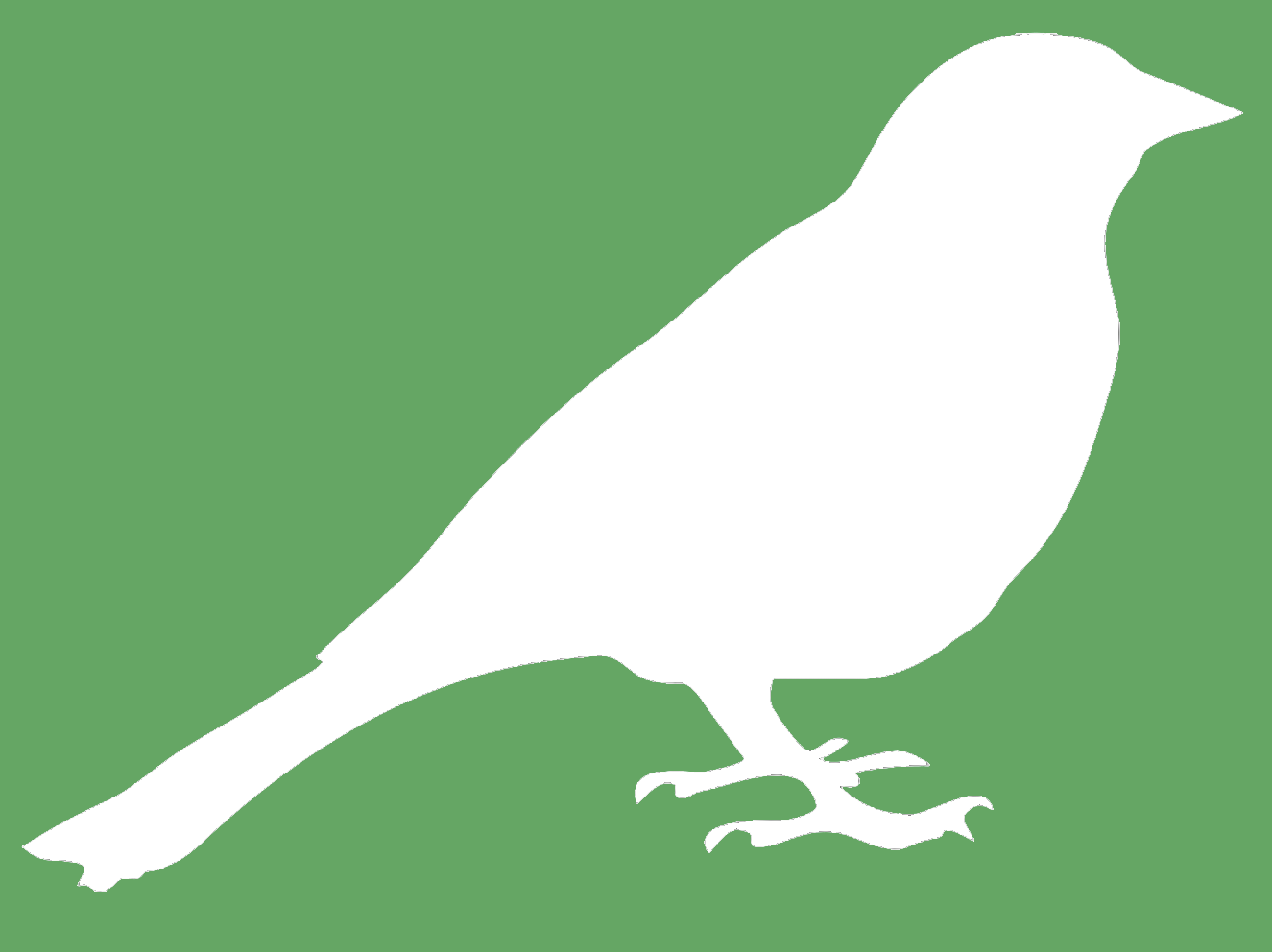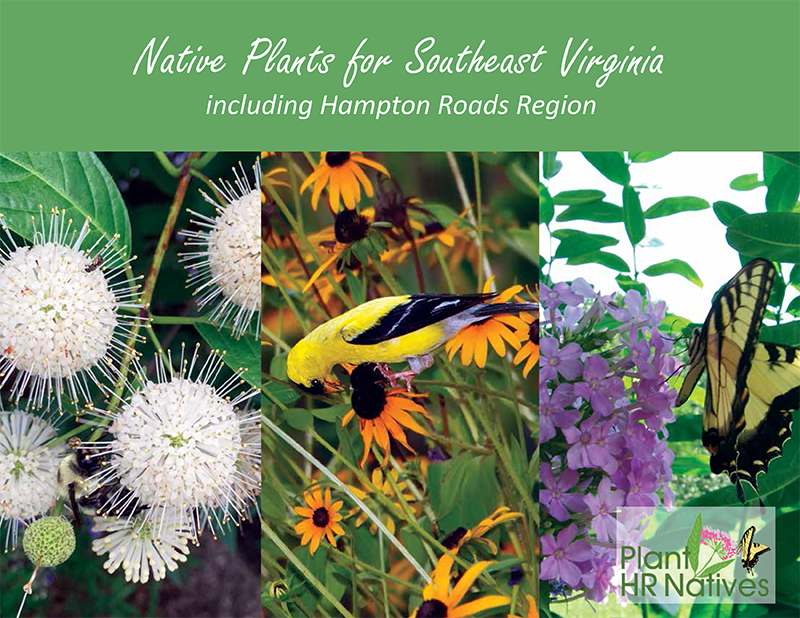Planting Natives to Attract Pollinators
A bee feeding on the nectar of White Turtlehead, Chelone glabra. This plant is also a nectar source for butterflies and is a larval host of the Baltimore Checkerspot butterfly (Euphydryas phaeton). Photo by Trista Imrich. Photo cannot be reproduced without permission.
Native plants attract a variety of butterflies, moths and other pollinators by providing diverse habitats and food sources. Native plants feed the insects that are the base of the food web, and insects that are especially important as food for young songbirds.
Black and White Warbler (Mniotilta varia) with Horace's Duskywing moth caterpillar (Erynnis horatius) by Virginia Witmer, Virginia CZM Program.
A bee covered in pollen, feeds on Blue Vervain (Verbena hastata) flower nectar. Photo by Jan Newton. Cannot be reproduced without permission.
We may not notice the hummingbirds, bats, bees, beetles, butterflies, and flies that carry pollen from one plant to another as they collect nectar, yet without them, wildlife would have fewer nutritious berries and seeds and we would miss many fruits, vegetables, and nuts.
By planting a diverse palette of native plants, we invite not only the plant-eating insects, but also their predators as well as pollinators, seed dispersers, and recyclers, which work together to make a garden function like a system. Because our native plants and animals have evolved together, they support each other, and we enjoy the beauty and fruits of their labor.
With a simple, but profound, observation that nothing was eating the Multiflora Rose he was clearing from his property, Dr. Douglas Tallamy launched a line of research that has become a cornerstone of the native plant movement. He has shown that not all plants are of equal value to wildlife and that native wildlife prefers native plants. For example, native oaks support 532 species of native caterpillars, while the non-native Butterfly Bush supports only one. Caterpillars are important because they are the primary food source for nestlings of 96 percent of all bird species. This insight led to a call embodied in the title of his book Bringing Nature Home to share our suburban landscape with wildlife by planting native plants.
Reduce Your Lawn
One important aspect of landscaping for wildlife is a change in the status of turf grass. It is not that turf no longer has a place in your landscape, but it is high maintenance, high cost, and low wildlife value. Each square foot of turf should be examined and subjected to the question “Why?” Sometimes turf is the right cover, but that should be decided only after consideration of native plant alternatives like Pennsylvania Sedge, moss, or other materials such as mulch or stepping stones.
Monarch caterpillar enjoying milkweed. Photo by Carol Heiser.
Meet Your needs and wildlife needs
The use of native plants in landscaping should not and does not preclude designing a landscape that meets your needs. Landscaping for wildlife should be a mix of human and natural design concepts. The overall plan should satisfy your needs—a place for the kids and dog to play and a quiet place to sit and enjoy your yard—and should follow human design concepts. But, the execution of the plan should be informed by nature’s design concepts: using plants in layers; avoiding straight lines; and smoothing forest into field into wetland.
Planting native plants has dramatically increased the life on our property. A video by a partner in the Plant NOVA Natives Campaign.
Dr. Robyn Puffenbarger meets Susan Roth and Jim Hurley at their home in Stanardsville to see how they transformed a traditional ornamental garden into a pollinator haven and created a meadow of native flowers and grasses.
Peggy Singlemann visits Dee Hall Godwin at Mermaid City Flowers in Norfolk, a cut flower micro-farm that uses sustainable methods to grow native perennials which support wildlife.
Shana Williams shares tips for saving seeds and Amyrose Foll explains how pollinators help produce food in the vegetable garden.
Studio Extra:
Peggy is joined by Entomologist Alejandro Del-Pozo to demonstrate how pollinators see flowers of different colors and shapes.
Butterfly Weed, Asclepias tuberosa, is a magnet for butterflies. Asclepias species are critically important larval hosts and nectar sources for the Monarch Butterfly (Danaus plexippus). Photo by Jan Newton. Cannot be reproduced without permission.
Virginia Native Pollinator Seed Packet available
This seed packet contains six native Virginia wildflowers species that are statewide suitable and support pollinators and other wildlife like songbirds:
Butterflyweed (Asclepias tuberosa)
Sensitive Pea (Chaemecrista nictitans)
Black-eyed Susans (Rudbeckia hirta)
Eastern Gray Beardtongue (Penstemon canescens)
Wild Bergamot (Monarda fistulosa)
Smooth Blue Aster (Symphyotrichum laeve)
For purchase from the Virginia Department of Wildlife Resources - https://dwr.virginia.gov/wildlife/habitat/seed-packets/
Eastern Tiger Swallowtail butterfly (Papilio glaucus).
Above all: use a diverse array of native plants!
Look for these icons in the regional native plant guides. The indicate native plant species that provide food and shelter for birds, butterflies and other pollinators and their larvae.
As shown on the cover of the regional native plant guide for Southeast Virginia, a Goldfinch eats the seeds of a Blackeye Susan flower (Rudbeckia hirta; photo by Seig Kopinitz, John Clayton Chapter of the Virginia Native Plant Society), while a Eastern Tiger Swallowtail butterfly enjoys nectar from Garden Phlox (Phlox paniculata; photo by Jan Newton) and a bee feeds on the flower of a Buttonbush (Cephalanthus occidentalis; photo by Trista Imrich).
PlantS for the Monarch Butterfly
The Virginia Department of Conservation and Recreation has created the following list of Virginia native plants that monarch butterfly lovers can add to their gardens to support them throughout all stages of their life cycle:
Swamp milkweed: Leaves are critical for the egg and larvae stages. Pink blossoms provide nectar from July through August.
Butterfly weed: Leaves are food during the egg and larvae stages. Orange blossoms provide nectar from June through August.
New York aster: Purple flowers provide nectar from August through October.
Threadleaf coreopsis: Yellow flowers provide nectar from June through October.
Sneezeweed: Yellow flowers provide nectar from July through September.
Narrow-leaf sunflower: Yellow flowers provide nectar from September through October.
Oxeye sunflower: Yellow flowers provide nectar from June through September.
Eastern rosemallow: Pink flowers provide nectar from June through September.
Bee balm: Red flowers provide nectar from June through August.
Summer phlox: Lavender flowers provide nectar from July through September.
Sweet goldenrod: Yellow flowers provide nectar from August through October.
New York Ironweed: Purple flowers provide nectar from August through September.
Think like a pollinator when planting!
If you can’t grow a garden even a few containers on your patio or balcony can provide nectar and pollen for pollinators. Every Yard and Space Matters!
Go Native. Pollinators are “best” adapted to local, native plants, which often need less water than ornamentals.
Go Diverse. Plant a diversity of flowering species with abundant pollen and nectar and specific plants for feeding butterfly and moth caterpillars
Bee Homey. Make small piles of branches to attach chrysalis or cocoons. Provide hollow twigs, rotten logs with wood-boring beetle holes and bunchgrasses and leave stumps, old rodent burrows, and fallen plant material for nesting bees. Leave dead or dying trees for woodpeckers.
Bee Showy. Flowers should bloom in your garden throughout the growing season. Plant for spring, summer and fall flowers.
Bee Bountiful. Plant big patches of each plant species (better foraging efficiency.)
Bee Sunny. Provide areas with sunny, bare soil that’s dry and well-drained, preferably with south-facing slopes.
Bee Aware. Observe pollinators when you walk outside in nature. Notice which flowers attract bumble bees or solitary bees, and which attract butterflies.
Bee Gentle. Most bees will avoid stinging and use that behavior only in self-defense. Male bees do not sting.
Bee Chemical Free. Pesticides and herbicides kill pollinators.
Bee Patient. It takes time for native plants to grow and for pollinators to find your garden, especially if you live far from wild lands.
Bee a little messy. Most of our native bee species (70%) nest underground so avoid using weed cloth or heavy mulch.
WATCH This Webinar
PLIGHT OF THE POLLINATOR: HOW TO SUPPORT POLLINATING INSECTS
Celia Vuocolo, former Habitat & Stewardship Specialist, Piedmont Environmental Council and currently Working Lands for Wildlife Pollinator Coordinator- East · Quail Forever & USDA-NRCS
Pollinators and other native insects need a diverse array of native plants to survive and thrive. Learn who's who in Virginia's bee community, the basics of providing pollinator habitat, and how to broadly support some of Virginia's smallest residents by making your yard seem like a national park for insects!
For more information about planting for pollinators, go to Learn More About Landscaping with Natives.
Learn more about Pollinator species in the artwork on this page:
Rusty Patched Bumble Bee (Bombus affinis) - watch video to learn more about the status of this pollinator at https://www.youtube.com/watch?v=-vRMGiToAVg
Monarch Butterfly (Danaus plexippus)- learn more about how you can as an individual help save the Monarch butterfly at https://www.fws.gov/savethemonarch/individual.html
Horace’s Duskywing Moth (Erynnis horatius) - learn more about this moth at https://www.butterfliesandmoths.org/species/Erynnis-horatius
Snowberry Clearwing (Hummingbird) Moth (Hemaris diffinis) - learn more about this moth at https://www.butterfliesandmoths.org/species/Hemaris-diffinis and https://www.fs.fed.us/wildflowers/pollinators/pollinator-of-the-month/hummingbird_moth.shtml
All drawings by Virginia Witmer, Virginia CZM Program.



















